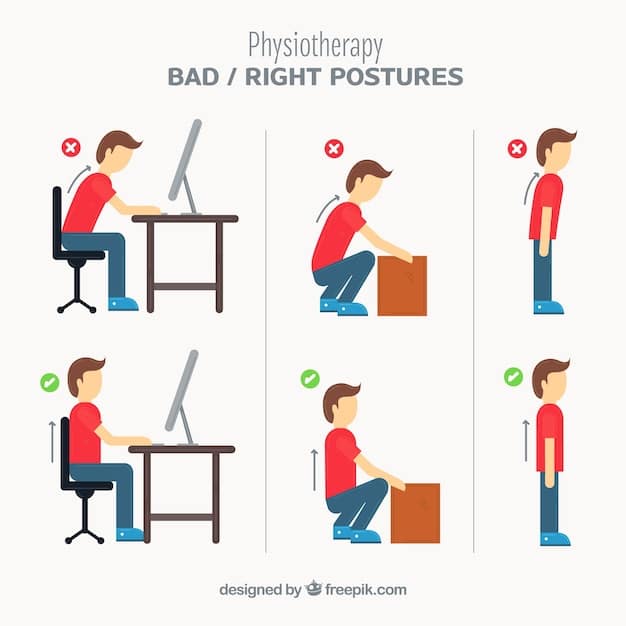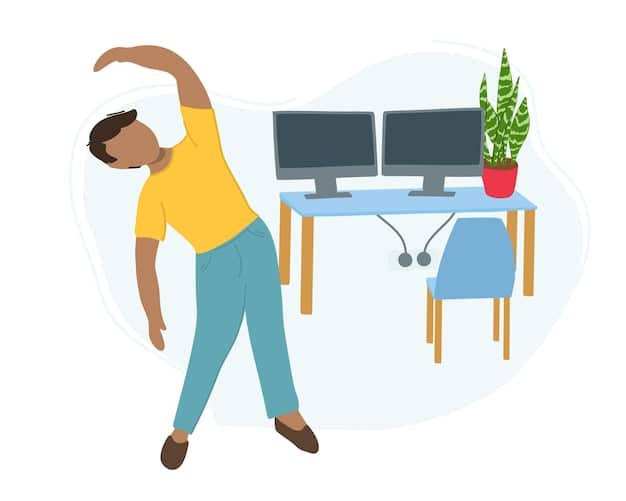Desk Detox: 5-Minute Posture Correction for Remote Workers

For remote workers battling desk-induced posture issues, a simple 5-minute routine can significantly alleviate discomfort and improve spinal alignment, integrating crucial corrective exercises into busy schedules to foster better long-term health and productivity.
For many remote workers, the line between workspace and living space has blurred, often leading to prolonged periods of sitting and compromised posture. This is where a Desk Detox: 5-Minute Posture Correction Routine for Remote Workers can be truly transformative.
the silent epidemic: understanding remote work posture challenges
The shift to remote work has brought unprecedented flexibility, but it has also introduced a unique set of challenges, particularly concerning physical well-being. What began as a temporary measure for many has evolved into a long-term professional landscape, revealing how prolonged periods spent at makeshift desks or on couches can silently erode one’s posture. This isn’t merely about superficial slouching; it’s a profound structural imbalance that can lead to a cascade of health issues.
Historically, office environments were often designed with ergonomics in mind, however imperfectly. Chairs might be adjustable, desks at optimal heights, and reminders to move more frequent. In contrast, home offices often lack these foundational elements. A dining room chair becomes a nine-to-five throne, a kitchen counter a standing desk, and a sofa a perilous trap for back health. The cumulative effect of these suboptimal setups is significant.
the physical toll of prolonged sitting
Prolonged sitting in an unsupportive environment places immense strain on the musculoskeletal system. The natural curves of the spine, particularly the cervical (neck) and lumbar (lower back) regions, are compromised. The head often juts forward, increasing the load on the neck and upper back muscles. This forward head posture, commonly known as “tech neck,” isn’t just unsightly; it can cause chronic headaches, jaw pain, and nerve impingement.
The shoulders tend to round forward, tightening the chest muscles and weakening the upper back. This creates a hunched appearance and restricts upper body movement. In the lower body, hip flexors become tight and shortened, while gluteal muscles weaken, impacting pelvic alignment and contributing to lower back pain. These imbalances don’t just feel uncomfortable; they can lead to degenerative changes in the spine over time.
more than just physical discomfort
Beyond the immediate aches and pains, poor posture can have broader, often overlooked implications for overall health and productivity. Chronic pain can erode focus, reduce energy levels, and negatively impact mood. When you’re constantly shifting in your seat or adjusting your neck, your cognitive resources are diverted. Concentration wanes, critical thinking becomes more challenging, and overall productivity declines.
Moreover, poor posture can affect respiratory function, as a hunched position restricts lung capacity. This can lead to shallower breathing, reduced oxygen intake, and feelings of lethargy. Long-term, such issues can contribute to fatigue, stress, and even sleep disturbances. Addressing posture isn’t just about avoiding a sore back; it’s about optimizing your physical capacity, mental clarity, and overall quality of life in a remote work setting. It’s an investment in sustainable productivity and well-being.
the 5-minute solution: building your desk detox routine
Facing the pervasive physical challenges of remote work, a simple yet effective solution often lies within reach. The Desk Detox: 5-Minute Posture Correction Routine for Remote Workers is designed to be precisely that: a swift, potent intervention that can be seamlessly integrated into even the busiest schedules. This isn’t about lengthy workout sessions or complex yoga flows; it’s about targeted movements that counteract the specific strains of desk work, offering immediate relief and fostering long-term postural health. The beauty of this routine lies in its accessibility and its emphasis on consistency over intensity.
foundational principles of effective posture correction
Before diving into the exercises, understanding the core principles that underpin effective posture correction is crucial. The goal is to restore the natural curves of the spine, release tension in overused muscles, and reactivate underactive ones.
* Awareness: The first step is cultivating an awareness of your current posture. How are you sitting right now? Where do you feel tension?
* Alignment: Focus on aligning your ears over your shoulders, shoulders over your hips, and hips over your ankles (if standing).
* Motion: Stagnation is the enemy of good posture. Regular, small movements are more beneficial than long periods of immobility.
* Breath: Deep, diaphragmatic breathing supports core stability and releases tension in the upper body.
This 5-minute routine capitalizes on these principles by guiding you through a series of movements that can be done right at your desk, requiring no special equipment, just a fleeting break from your screen.
crafting your personalized 5-minute routine
The following exercises are foundational and can be adapted to suit individual needs. The key is to perform each movement with intention, focusing on the stretch or activation you feel.
* Neck Retractions (Chin Tucks):
* Sit tall, looking straight ahead.
* Gently pull your chin straight back, as if making a double chin, keeping your eyes level.
* Feel the stretch at the base of your skull and neck.
* Hold for 5 seconds, release. Repeat 5-8 times. This combats forward head posture.
* Thoracic Extension over Chair Back:
* Scoot to the edge of your chair.
* Lean back, allowing your upper back (thoracic spine) to extend over the chair back. Place hands behind head for support.
* Gently lift your chest towards the ceiling, arching your upper back.
* Hold for 10-15 seconds. Repeat 3-4 times. Great for counteracting slouching.
* Doorway Chest Stretch (or desk-side variation):
* Stand in a doorway with forearms on doorframe, elbows at shoulder height.
* Gently lean forward until you feel a stretch in your chest.
* Hold for 20-30 seconds. If no doorway, place palms on either side of desk edge and lean in slightly. Repeat 2-3 times.
* Figure-Four Stretch (Seated Glute Stretch):
* While seated, cross one ankle over the opposite knee.
* Keep your back straight and gently lean forward from your hips until you feel a stretch in your glute.
* Hold for 20-30 seconds per side. Repeat for both legs. Addresses tight hips from sitting.
* Standing Overhead Reach with Side Bend:
* Stand up. Interlace fingers and push palms towards ceiling, lengthening spine.
* Gently bend to one side, stretching your obliques and lats.
* Hold for 10-15 seconds per side. Repeat for both sides. Lengthens the torso and promotes full body extension.
These simple, targeted movements directly address the most common postural issues associated with prolonged sitting: forward head posture, rounded shoulders, tight chest and hip flexors, and a stiff lower back. Incorporating even just one or two of these during a quick break can make a significant difference.

beyond the 5 minutes: integrating posture into your workday
While the Desk Detox: 5-Minute Posture Correction Routine for Remote Workers provides an excellent acute intervention for immediate relief and reset, its true power is unleashed when it becomes part of a broader, more conscious approach to your workday. Thinking beyond just the dedicated five minutes means embedding postural awareness and movement into the very fabric of your daily routine. This sustained effort is what yields lasting benefits, transforming not just how you sit, but how you feel and perform throughout the day.
The concept of a “desk detox” extends beyond specific exercises to encompass a holistic philosophy of mindful working. It’s about proactive prevention alongside reactive correction. This involves conscious adjustments to your environment, your habits, and your overall relationship with your workspace.
the power of micro-breaks and active awareness
It’s tempting to power through long stretches of work, but science consistently shows that our bodies and minds benefit from frequent, short breaks. These aren’t just opportunities to grab a coffee; they’re vital windows for postural resets.
* Hourly Reminders: Set a timer for every hour. When it goes off, stand up, stretch, or do a quick 30-second mobility exercise. Even a few shoulder rolls or ankle rotations can make a difference.
* Active Hydration: Instead of keeping a large water bottle at your desk, use a smaller one that requires you to get up and refill it more frequently. This builds movement into your hydration habits.
* The “Walk and Talk”: For phone calls or virtual meetings where you don’t need to be on camera, try walking around your room or house. This adds movement without disrupting your work flow.
These micro-breaks prevent the cumulative stiffness that builds up over hours of static posture. They encourage blood flow, awaken dormant muscles, and provide mental refreshment, making you more efficient when you return to your task.
optimizing your remote workspace ergonomics
While a perfect ergonomic setup isn’t always feasible at home, significant improvements can often be made with minimal investment. Small adjustments can yield substantial benefits.
* Chair Support: If your chair lacks lumbar support, roll up a towel or use a small pillow. Ensure your feet are flat on the floor or supported by a footrest, and your knees are at a 90-degree angle.
* Monitor Height: Position your monitor so the top third of the screen is at eye level. This prevents neck strain from looking down or craning up. If using a laptop, consider an external monitor or a stand.
* Keyboard and Mouse: Keep your keyboard and mouse close to avoid reaching. Your elbows should be at roughly a 90-degree angle, and your wrists straight.
* Lighting: Good lighting reduces eye strain, which can indirectly contribute to neck and shoulder tension as you squint or lean in.
Understanding these simple principles allows you to create a more supportive environment, reducing the need for constant correction. It’s about setting yourself up for success from the beginning of your workday.
the ripple effect: how better posture boosts productivity and well-being
The immediate and tangible benefits of the Desk Detox: 5-Minute Posture Correction Routine for Remote Workers are clear: reduced pain, increased flexibility, and improved alignment. However, the true impact of integrating this conscious approach to posture extends far beyond physical comfort. It creates a powerful ripple effect that touches virtually every aspect of a remote worker’s life, significantly boosting both productivity and overall well-being. This isn’t just about feeling better; it’s about performing better, thinking clearer, and living more fully.
The intricate connection between our physical state and our mental-emotional state is often underestimated. When our bodies are free from chronic discomfort and are properly aligned, our minds are liberated to focus on higher-level tasks, creativity, and problem-solving, rather than being distracted by persistent aches.
enhanced focus and cognitive function
Chronic pain is a notorious mental disruptor. Constant nagging in your neck, shoulders, or back acts like background noise, diverting cognitive resources away from your primary tasks. By alleviating this discomfort through regular postural adjustments and exercises, you free up mental bandwidth.
* Reduced Distraction: When you’re not constantly shifting or fidgeting due to discomfort, your ability to concentrate on complex tasks improves dramatically. This leads to deeper work and fewer errors.
* Improved Blood Flow: Good posture facilitates better circulation throughout the body, including to the brain. Increased oxygen and nutrient delivery to brain cells can enhance cognitive functions such as memory, attention span, and processing speed.
* Reduced Fatigue: Poor posture can be surprisingly energy-draining, as your muscles work harder to compensate for misalignment. Correcting this conserves energy, leading to sustained alertness and less mental fatigue throughout the workday.
Ultimately, a body that feels good supports a mind that thinks clearly and efficiently. This translates directly into higher-quality work and increased output.
elevated mood and stress reduction
The link between physical posture and psychological state is well-documented. Studies suggest that simply adopting an upright, expansive posture can positively influence mood and resilience.
* Boost in Confidence: A strong, upright posture projects confidence and can actually make you feel more confident and assertive in virtual meetings or interactions.
* Decreased Stress Hormones: Slouching can trigger the release of cortisol, the stress hormone, while an upright posture has been shown to reduce it. By embodying better posture, you can mitigate the physiological stress response.
* Improved Breathing: Good posture allows for full, deep diaphragmatic breathing. This type of breathing activates the parasympathetic nervous system, promoting relaxation and reducing feelings of anxiety. When your body is open, your breath is deeper, and your mind is calmer.
The emotional benefits of a good Desk Detox routine are profound, contributing to a more positive and less stressful remote work experience. It’s a foundational step towards greater self-efficacy and resilience.
common postural pitfalls & how to avoid them
Even with the best intentions, remote workers often fall prey to common postural pitfalls that undermine their efforts. Recognizing these traps is the first step toward correcting them and ensuring that your Desk Detox: 5-Minute Posture Correction Routine for Remote Workers provides lasting benefits. It’s not just about what you do for five minutes, but also about what you avoid doing for the other hours of your day. These bad habits, often unconscious, accumulate over time, leading to significant strain and discomfort.
the seductive slouch: perils of relaxed positioning
Ah, the slouch. It feels so comfortable in the moment, yet it’s one of the most damaging posture habits. Whether it’s leaning back too far in an unsupported chair, sinking into a sofa, or hunching over a laptop in bed, relaxed positions often lead to severe spinal misalignment.
* Lower Back Rounding: Slouching flattens the natural lumbar curve, putting excessive pressure on discs and ligaments in the lower back. This is a common precursor to chronic lower back pain.
* Forward Head Posture Exacerbation: When you slouch, your head instinctively juts forward to keep your eyes level with the screen, dramatically increasing strain on the neck and upper back.
* Shoulder Rounding: A relaxed slouch also encourages the shoulders to roll forward, tightening the chest and weakening the upper back muscles, leading to a hunched appearance and potential shoulder impingement.
The solution isn’t to be rigid, but to maintain awareness. Every few minutes, gently realign your spine, engage your core, and check your head and shoulder position.
the tech neck trap: constant downward gaze
Smartphones, tablets, and even laptops often encourage a downward gaze, leading to the dreaded “tech neck.” This habit places immense strain on the cervical spine and surrounding musculature.
* Increased Stress on Neck: For every inch your head moves forward, the weight on your neck muscles effectively doubles. A head tilted just 15 degrees forward puts 27 pounds of pressure on your neck!
* Chronic Headaches and Jaw Pain: The constant tension in the neck and upper back muscles can radiate, causing tension headaches, migraines, and even temporomandibular joint (TMJ) dysfunction.
* Weakness and Imbalance: Muscles in the front of the neck become shortened and tight, while those in the back become overstretched and weak, leading to chronic imbalances.
To combat tech neck, raise your screens to eye level whenever possible. When using a phone, bring the phone up to your eye line instead of craning your head down. Regularly integrate neck retractions (chin tucks) into your routine.
the limb lock: static limb positions
Many remote workers remain in static positions for extended periods, locking their knees, crossing their legs, or bracing their arms. While seemingly benign, these habits can impede circulation and create muscular imbalances.
* Restricted Blood Flow: Crossing legs or locking knees can compress blood vessels, reducing circulation to the lower extremities and leading to numbness or tingling.
* Pelvic Imbalances: Habitually crossing legs can lead to a rotated pelvis over time, affecting hip and lower back alignment.
* Shoulder Impingement: Resting elbows heavily on a desk or maintaining a static arm position for too long can lead to nerve compression or shoulder pain.
Practice dynamic sitting: shift your weight, uncross your legs, and change your arm positions frequently. Every 20-30 minutes, stand up and walk a few steps to reset your body.
By consciously avoiding these common pitfalls and pairing that awareness with regular application of your desk detox routine, you create a powerful defense against the physical toll of remote work.
sustaining the change: long-term strategies for postural health
The immediate relief and enhanced awareness derived from the Desk Detox: 5-Minute Posture Correction Routine for Remote Workers are excellent starting points. However, true and lasting postural health, especially in the context of remote work, requires a commitment to sustaining these changes over the long term. This isn’t about fleeting efforts but about embedding good habits so deeply that they become second nature. It’s a continuous journey of self-care that reaps cumulative benefits, transforming your relationship with your body and your workday.
Sustainability in posture correction hinges on three key pillars: consistency, progression, and listening to your body’s signals. It’s less about achieving a perfect posture and more about cultivating resilient, adaptable movement patterns that serve you well every day.
consistency is key: making it a daily habit
The most potent tool for long-term postural health is consistency. A five-minute routine done daily is far more effective than an hour-long session once a week.
* Routine Integration: Anchor your 5-minute routine to an existing daily habit. Perhaps it’s right after your morning coffee, before lunch, or when you switch from email to deep work. This “habit stacking” makes it harder to forget.
* Visual Reminders: Place sticky notes with simple posture cues (e.g., “shoulders down,” “chin tuck”) on your monitor, or use a standing desk reminder app.
* Buddy System: If you have remote colleagues, share your intention to improve posture. You can even set up quick “stretch breaks” together in a shared virtual space. Mutual accountability can be a powerful motivator.
Embracing consistency transforms these actions from tasks into integral parts of your workday rhythm, making postural awareness second nature.
progression and adaptation: listening to your body
While the 5-minute routine is a strong foundation, your body’s needs may evolve. Long-term success involves listening to your body and incrementally progressing or adapting your approach.
* Notice Pain Patterns: Pay attention to where and when you experience discomfort. Does it consistently flare up after specific tasks or times? This can indicate which areas need more attention.
* Deepen Stretches: As flexibility improves, you might find you can deepen certain stretches or hold them for slightly longer, always respecting your body’s limits.
* Incorporate Strength: Beyond basic stretches, consider adding simple resistance exercises that strengthen core and upper back muscles. Resistance bands are excellent for this and easily portable. Examples include band pull-aparts for upper back strength.
* Vary Your Workspace: If feasible, change your working position periodically throughout the day. Alternate between sitting, standing, or even perching, if you have the equipment. This prevents any single position from becoming a static strain.
Progression isn’t about pushing through pain, but about gently coaxing your body into greater strength and flexibility over time. It’s a continuous conversation with yourself.
the holistic view: sleep, hydration, and nutrition
Posture is not an isolated phenomenon; it’s intricately linked to overall physical health. Optimal sleep, proper hydration, and nutritious food play crucial roles in muscle recovery, tissue elasticity, and overall energy levels, all of which impact your ability to maintain good posture.
* Quality Sleep: Adequate sleep allows muscles and connective tissues to repair and recover. Sleeping in a supportive position (e.g., on your back with a pillow supporting the neck’s natural curve, or side-sleeping with a pillow between the knees) also contributes significantly.
* Hydration: Water is essential for the health of intervertebral discs and the lubrication of joints. Dehydration can exacerbate stiffness and discomfort.
* Balanced Nutrition: A diet rich in anti-inflammatory foods (fruits, vegetables, lean proteins) supports muscle health and reduces systemic inflammation that can contribute to pain.
By embracing a holistic approach to wellness, you create a robust foundation upon which sustainable postural health can thrive. The Desk Detox then becomes not just a routine, but a cornerstone of a healthier, more productive remote work life.
| Key Point | Brief Description |
|---|---|
| 🧘♀️ 5-Minute Routine | Quick, targeted exercises to correct posture, reduce pain, and improve alignment during work breaks. |
| 🖥️ Ergonomic Setup | Optimize your desk, chair, and monitor height to prevent strain and support natural spinal curves. |
| 🧠 Enhanced Productivity | Better posture reduces discomfort, boosts focus, and improves energy levels for higher work efficiency. |
| 🔄 Consistent Practice | Daily integration of micro-breaks and exercises is crucial for long-term postural health benefits. |

frequently asked questions about desk detox and posture
For remote workers, prolonged periods of sitting in often non-ergonomic home environments can lead to significant postural issues like neck pain, backaches, and rounded shoulders. Correcting posture alleviates these pains, improves circulation, increases energy levels, and enhances overall comfort and productivity throughout the workday, preventing long-term musculoskeletal problems.
Absolutely. While seemingly short, a consistent 5-minute routine of targeted stretches and corrective exercises can be remarkably effective. It disrupts prolonged static postures, releases built-up tension, and reactivates underused muscles, providing immediate relief and preventing the accumulation of strain. Consistency is key; daily short breaks are more beneficial than sporadic long ones.
Common mistakes include slouching forward, leading to a flattened lower back curve; developing “tech neck” from looking down at screens; rounding shoulders; and keeping limbs in static, locked positions (like crossed legs). These habits create muscular imbalances and undue stress on the spine, contributing to discomfort and potential long-term issues if not addressed.
To ensure consistency, integrate your routine into existing daily habits, such as doing it right after logging in, before lunch, or during a specific meeting break. Setting hourly reminders on your phone or computer, placing visual cues like sticky notes around your desk, or using habit-tracking apps can also significantly help in establishing and maintaining the routine.
Beyond the routine, optimizing your workspace ergonomics is vital—ensure your chair provides good lumbar support, your monitor is at eye level, and your keyboard and mouse are positioned for comfort. Additionally, taking frequent micro-breaks to stand and move, staying hydrated, getting quality sleep, and incorporating overall physical activity contribute to sustained postural health.
conclusion
The landscape of remote work, while offering unparalleled flexibility, has undeniably reshaped our physical habits, often at the expense of our posture. The insidious creep of “tech neck,” rounded shoulders, and persistent back pain can significantly diminish both our comfort and our capacity for productive work. Yet, the remedies are often simpler and more accessible than many realize. The Desk Detox: 5-Minute Posture Correction Routine for Remote Workers is more than just a series of exercises; it’s an invitation to a more mindful, pain-free, and ultimately more productive way of working. By consistently dedicating mere minutes each day to these targeted movements, coupled with an increased awareness of your ergonomic environment and daily habits, you can reclaim control over your postural health. This holistic approach not only alleviates current discomfort but also builds a resilient foundation for long-term well-being, transforming your remote work experience into one of sustained vitality and focus. Embrace this desk detox, and you’ll find that a small investment of time yields profound dividends in your overall health and professional efficacy.





